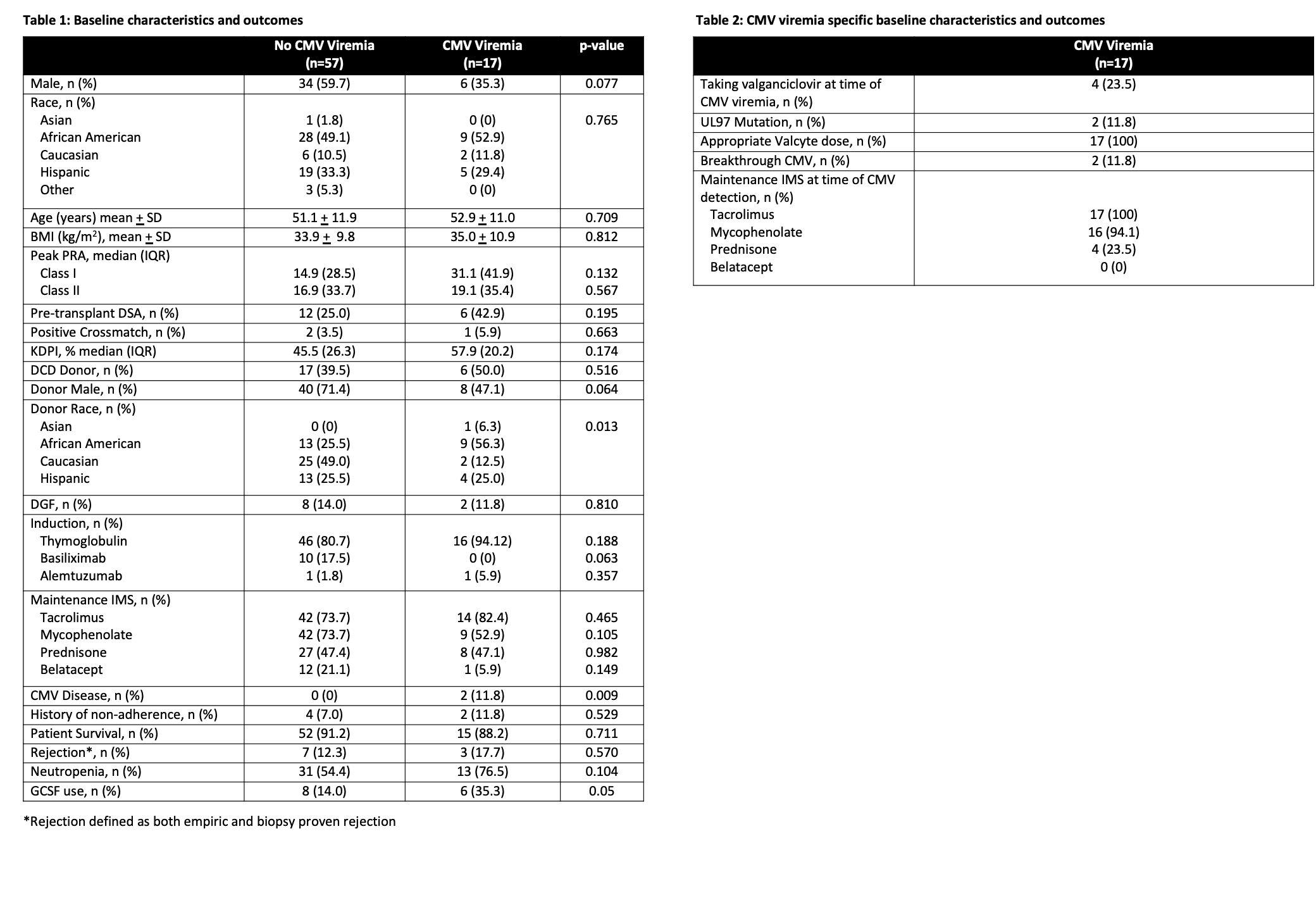Evaluation of Prophylactic Valganciclovir Dosing in Kidney Transplant Recipients at an Urban Transplant Institution
E. Foster1, D. Pierce1, T. Cairns1, S. Borgetti2, I. Tzvetanov3, E. Benedetti3, C. Muran1
1Pharmacy, University of Illinois at Chicago, Chicago, IL, 2Medicine, University of Illinois at Chicago, Chicago, IL, 3Surgery, University of Illinois at Chicago, Chicago, IL
Meeting: 2022 American Transplant Congress
Abstract number: 991
Keywords: Cytomeglovirus, High-risk, Infection, Prophylaxis
Topic: Clinical Science » Infection Disease » 25 - Kidney Infectious Non-Polyoma & Non-Viral Hepatitis
Session Information
Session Name: Kidney Infectious Non-Polyoma & Non-Viral Hepatitis
Session Type: Poster Abstract
Date: Sunday, June 5, 2022
Session Time: 7:00pm-8:00pm
 Presentation Time: 7:00pm-8:00pm
Presentation Time: 7:00pm-8:00pm
Location: Hynes Halls C & D
*Purpose: Dosing and duration of cytomegalovirus (CMV) prophylaxis with valganciclovir (VGC) in kidney transplant (KT) recipients is variable by transplant center. Prior studies have shown VGC 450 mg daily is non-inferior to 900 mg daily for CMV prophylaxis in KT recipients. There are limited outcomes reported about efficacy of VGC 450 mg daily in high immunologic risk and obese KT recipients.
*Methods: This was a single-center retrospective chart review of adult patients who underwent an isolated KT between 2/1/2020 – 1/31/2021 and received VGC 450 mg daily (renally dose adjusted) for CMV prophylaxis. The primary outcome was CMV viremia. Baseline characteristics, immunosuppression information, and secondary outcomes were assessed, comparing patients who met the primary outcome of CMV viremia to those who did not.
*Results: A total of 74 patients met inclusion criteria. Patients were predominantly African American (50.0%) males (54.1%) with an average age of 51.5 + 11.7 years and a mean body mass index (BMI) of 34.2 + 10.0 kg/m2. Seventeen patients (23.0%) developed CMV viremia and 2 patients (2.7%) developed CMV disease. Baseline characteristics were similar between patients with CMV viremia and those without (Table 1). The rate of thymoglobulin induction was not statistically different between groups, although there was a numerically higher rate of thymoglobulin induction in patients with CMV viremia (80.7% vs 94.1%; P= 0.188). No patients who received basiliximab induction developed CMV viremia. Significantly more patients with CMV viremia had black race donors (25.5% vs 56.3%; P=0.013). Most patients (76.5%) with CMV viremia were no longer on VGC prophylaxis at the time of CMV viremia. All patients that did develop breakthrough CMV viremia (4/17) were on an appropriate VGC dose at the time of CMV viremia, of which 50% developed UL97 resistance (Table 2). There was no statistically significant difference in rate of belatacept maintenance therapy between groups (21.1% vs 5.9%; P =0.149).
*Conclusions: Although data collection is still ongoing, these results suggest that the efficacy of VGC 450 mg daily in preventing CMV disease and viremia extends to high-immunologic risk and obese populations, as well as patients on novel immunosuppression agents such as belatacept.
To cite this abstract in AMA style:
Foster E, Pierce D, Cairns T, Borgetti S, Tzvetanov I, Benedetti E, Muran C. Evaluation of Prophylactic Valganciclovir Dosing in Kidney Transplant Recipients at an Urban Transplant Institution [abstract]. Am J Transplant. 2022; 22 (suppl 3). https://atcmeetingabstracts.com/abstract/evaluation-of-prophylactic-valganciclovir-dosing-in-kidney-transplant-recipients-at-an-urban-transplant-institution/. Accessed December 15, 2025.« Back to 2022 American Transplant Congress

